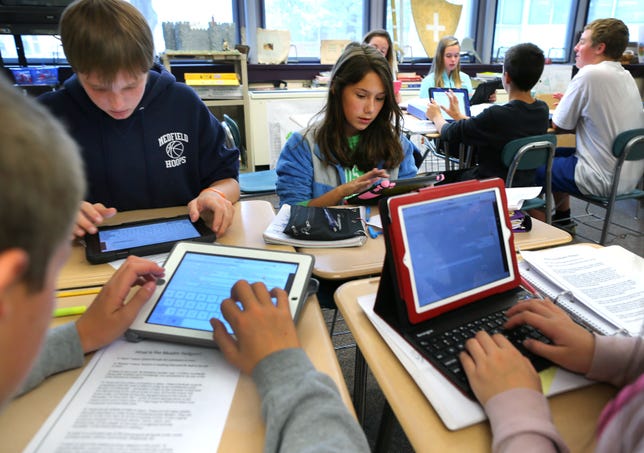
Boston Globe via Getty Images
Amazon’s efforts to grow in education look to be paying off so far.
Since the company in 2012 started offering Whispercast — a free service for schools to distribute e-textbooks, course material and apps to hundreds or thousands of school-controlled computers — it has expanded into thousands of districts and universities. The e-commerce giant said Tuesday Whispercast is now used in more than 130 of the 250 largest school districts in the US and over 2,400 higher education organizations, including 24 of the 30 largest in the country.
To keep up that momentum, Amazon on Tuesday released an updated version of Whispercast to give teachers and professors more flexibility to purchase and share materials through the service. The company is also now starting to offer free expert guidance for districts to start using Whispercast.
“In the past couple of years, we’ve learned a lot about how these school districts are all deploying content in a very unique way,” Rohit Agarwal, general manager of Amazon Education, said about the changes to Whispercast.
The service is just a small piece of Amazon’s sprawling empire, with its core online retail store bolstered by a Hollywood production arm, a cloud-based data center unit, a tablet and set-top box business, and plenty else. Still, Whispercast is an important way for Amazon — which started as a bookseller — to gain exposure in the more than $20 billion market for K-12 and higher-education information-technology products and services, according to the Center for Digital Education. There are many other tech players, including Apple and Google, that are working to provide devices and services to schools, but the more schools Amazon can convert to its system, the more money it can potentially generate from it.
“We have lots of free books in our library, but there are a lot of books out there as well that do cost money,” said Dave Limp, senior vice president of Amazon Devices. “And we hope that by using Whispercast, some of those customers buy those books from us.”
Whispercast can distribute rented or purchased e-books, apps and other material to devices deployed in schools, including Amazon’s own Kindle e-readers and Fire tablets, as well as Chromebooks, Macs, PCs and devices running on Google’s Android or Apple’s iOS mobile operating systems. Schools using Amazon’s own devices with Whispercast have greater control of their device setting, including blocking Facebook, blocking changes to Wi-Fi settings and blocking the web browser.
With the newly designed Whispercast 3.0, administrators can now delegate more control on purchasing and distributing materials to teachers, so all functions of the service don’t have to run through a central administrative office. Also, in addition to the current self-service model of Whispercast, Amazon now offers free service representatives to help schools transition to the digital platform.
Some businesses already use Whispercast to disseminate materials, and Amazon hopes to build that part of the service in the future. But, for now, the education field is the main place Whispercast is used.
There’s been a huge push to put more tablets and laptops in the hands of students, but that effort hasn’t always been easy. This month, the Los Angeles Unified School District said it’s demanding a refund of millions of dollars from Apple for the tech giant’s program to give each district student an iPad tablet. The district-funded project went over budget, the curriculum was deemed ineffective, and students began hacking the iPads to surf the Web and use them for non-school related activities, the Los Angeles Times reported.
While noting that Amazon was not involved in that project, Limp said it was important to take an all-encompassing approach when rolling out such programs.
“The opportunity isn’t over the second you sign for the device — in fact, that’s the easy part,” Limp said. “It is the simple first step, but there are thousands of additional steps after that to make it successful,” from teacher training to curriculum to bringing together the right material.




